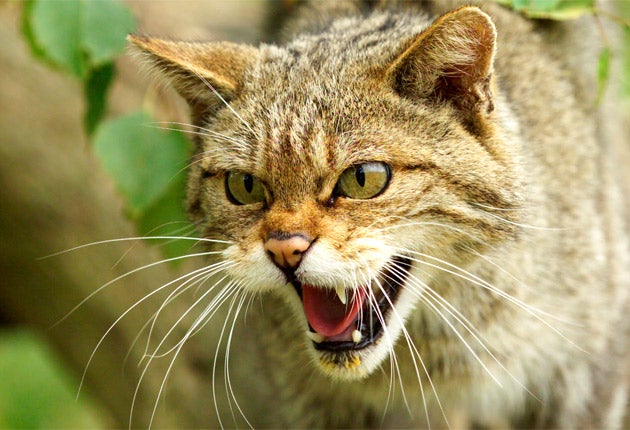How domestic cats could save the 'Highland tiger'

Pound for pound, they are as fierce as their full-size counterparts but their dwindling numbers mean "Highland tigers" are also just as endangered. With only 400 Scottish wildcats thought to be living in the wild, scientists are now preparing a radical new approach to saving the the rare felines.
The controversial plan involves the recruitment of the domestic cat, a completely different species, to help save Britain's most iconic mammalian predator. The project is set to raise eyebrows among some animal conservationists, not least because it is the domestic moggie that is arguably the Scottish wildcat's biggest problem.
The domestic cat, which originated from another species of wildcat living in the Middle East, is threatening the extinction of the pure-bred Scottish wildcat by interbreeding, which dilutes the wildcat's precious gene pool. But the scientists behind the new initiative believe that house cats can play a critical role in preserving the wildcat's threatened genes with the help of artificial reproductive technology. Zoologists and reproductive specialists intend to develop revolutionary cloning techniques that build on scientific knowledge of the domestic cat's reproductive system.
The project, funded by the Royal Zoological Society of Scotland with expertise drawn from the Medical Research Council's (MRC) Human Reproductive Sciences Unit in Edinburgh, is being seen as a template for other initiatives aimed at helping endangered animals with cloning technology.
Iain Valentine, director of animals, conservation and education at the Society, said the plan is to collect and store tissue samples from Highland wildcats in order to use them at some future point in time when scientists work out the best way of boosting their numbers in the wild with the help of artificial reproductive technology.
"It makes absolute sense to me because we are running out of time to work out how to manage these animals in the wild, and so the best thing we can do is collect cells, bang them in the freezer, bank it for a future date and hope that we can get the bits of the equation sorted out in the wild as well," Dr Valentine said.
Traditional approaches to wildcat conservation, centred on restoring its natural habitat, are not being abandoned, but augmented by the new technology of reproductive biology, he said. "For conservationists, looking after these animals in the wild is fundamental. [We] are talking about another tool in the box and a lot of conservationists haven't actually switched on to this. At a time when we are losing species across the planet at a huge rate of knots, we're going to need everything we can," he said.
"We're still at the early stages of talking about applying this technology to the Scottish wild cat but it seems to me an absolutely perfect candidate species for it. The domestic cat and its biology and physiology is pretty well understood, so if we can take what we know about the domestic cat to unlock a little bit more about the biology of the wild cat, we will have a very powerful tool we can apply," Dr Valentine said.
The project will involve the Zimbabwean-born director of the MRC unit, Professor Robert Millar, who has helped to establish an institute for the breeding of endangered African mammals using reproductive techniques used on domesticated animals. One approach in particular, where animals are created by a cloning technique known as induced pluripotent stem (iPS) cells, is being developed with a view to saving mammals such as the highly-endangered northern white rhino, Professor Millar said.
"Our first priority is to preserve their environments, to conserve the species in situ. But if you happen to lose those environments you need to go to plan B, but that doesn't mean that you won't be able to restore those environments sometime in the future and reintroduce animals," Professor Millar said.
"We believe it is more do-able than we thought in the past. It would be good to do this as an insurance policy because you never know when there is going to be a calamitous decline."
The project has recruited expert embryologist Bill Ritchie, who created Dolly the sheep at the nearby Roslin Institute, as a special adviser.
To be brought back?
Northern white rhino
Thought to be extinct in the wild after a recent expedition to the Congo failed to find any. One plan is to use southern white rhinos to act as surrogates for a cloning-based, captive-breeding programme.
Ethiopian wolf
The population of this rare carnivore plummeted from about 400 to 200 individuals in one season following a rabies epidemic thought to be introduced by feral dogs. Attempts to store tissue samples, including semen, are already well advanced.
Pygmy hippo
This shy species, a native of west Africa, stands on the extinction abyss. Much work has gone into understanding the complex reproductive biology of this reclusive, nocturnal animal and scientists hope this knowledge will be used to boost its numbers with the help of artificial reproductive techniques.
Join our commenting forum
Join thought-provoking conversations, follow other Independent readers and see their replies
Comments